Experimental Study on the Strength Deterioration and Mechanism of Stabilized River Silt Reinforced with Cement and Alginate Fibers
Abstract
:1. Introduction
2. Materials and Experimental Methods
2.1. Materials
2.2. Specimen Preparation
2.3. Test Scheme and Methods
2.3.1. F–T Cycle Test
2.3.2. W–D Cycle Test
2.3.3. Water Immersion Tests
2.3.4. Seawater Erosion Test
2.3.5. SEM Imaging
3. Test Results and Discussion
3.1. F–T Cycle Test
3.2. W–D Cycle Test
3.3. Residual Strength Index Model of W–D Cycles
3.4. Water Immersion Test
3.5. Seawater Erosion Test
3.6. SEM Imaging
4. Conclusions
Author Contributions
Funding
Institutional Review Board Statement
Informed Consent Statement
Data Availability Statement
Conflicts of Interest
References
- Zhang, X.; Fang, X.; Liu, J.; Wang, M.; Shen, C.; Long, K. Durability of Solidified Sludge with Composite Rapid Soil Stabilizer under Wetting-Drying Cycles. Case Stud. Constr. Mater. 2022, 17, e01374. [Google Scholar] [CrossRef]
- Zhang, T.; Liu, S.; Zhan, H.; Ma, C.; Cai, G. Durability of Silty Soil Stabilized with Recycled Lignin for Sustainable Engineering Materials. J. Clean Prod. 2020, 248, 119293. [Google Scholar] [CrossRef]
- He, J.; Li, Z.; Wang, X.; Shi, X. Durability of Soft Soil Treated with Soda Residue and Ground Granulated Blast Furnace Slag in a Soaking Environment. J. Mater. Civ. Eng. 2020, 32, 06019018. [Google Scholar] [CrossRef]
- Zhang, H.; Tian, L.; Wang, S.; Qiao, Y.; Ahmed, M. Experimental Study on Engineering Properties of Fiber-Stabilized Carbide-Slag-Solidified Soil. PLoS ONE 2022, 17, e0266732. [Google Scholar] [CrossRef]
- Tiwari, N.; Satyam, N.; Puppala, A.J. Strength and Durability Assessment of Expansive Soil Stabilized with Recycled Ash and Natural Fibers. Transp. Geotech. 2021, 29, 100556. [Google Scholar] [CrossRef]
- Behnood, A. Soil and Clay Stabilization with Calcium- and Non-Calcium-Based Additives: A State-of-the-Art Review of Challenges, Approaches and Techniques. Transp. Geotech. 2018, 17, 14–32. [Google Scholar] [CrossRef]
- Celik, E.; Nalbantoglu, Z. Effects of Ground Granulated Blastfurnace Slag (GGBS) on the Swelling Properties of Lime-Stabilized Sulfate-Bearing Soils. Eng. Geol. 2013, 163, 20–25. [Google Scholar] [CrossRef]
- Silveira, M.V.; Calheiros, A.V.; Casagrande, M.D.T. Applicability of the Expanded Polystyrene as a Soil Improvement Tool. J. Mater. Civ. Eng. 2018, 30, 06018006. [Google Scholar] [CrossRef]
- Mirzababaei, M.; Arulrajah, A.; Horpibulsuk, S.; Soltani, A.; Khayat, N. Stabilization of Soft Clay Using Short Fibers and Poly Vinyl Alcohol. Geotext. Geomembr. 2018, 46, 646–655. [Google Scholar] [CrossRef]
- Talluri, N.; Puppala, A.J.; Congress, S.S.C.; Banerjee, A. Experimental Studies and Modeling of High-Sulfate Soil Stabilization. J. Geotech. Geoenviron. Eng. 2020, 146, 04020019. [Google Scholar] [CrossRef]
- Jalal, F.E.; Xu, Y.; Jamhiri, B.; Memon, S.A. On the Recent Trends in Expansive Soil Stabilization Using Calcium-Based Stabilizer Materials (CSMs): A Comprehensive Review. Adv. Mater. Sci. Eng. 2020, 2020, 1–23. [Google Scholar] [CrossRef]
- Tiwari, N.; Satyam, N.; Singh, K. Effect of Curing on Micro-Physical Performance of Polypropylene Fiber Reinforced and Silica Fume Stabilized Expansive Soil Under Freezing Thawing Cycles. Sci Rep 2020, 10, 7624. [Google Scholar] [CrossRef] [PubMed]
- Fatahi, B.; Fatahi, B.; Le, T.M.; Khabbaz, H. Small-Strain Properties of Soft Clay Treated with Fibre and Cement. Geosynth. Int. 2013, 20, 286–300. [Google Scholar] [CrossRef]
- Liu, L.; Deng, T.; Deng, Y.; Zhan, L.; Horpibulsuk, S.; Wang, Q. Stabilization Nature and Unified Strength Characterization for Cement-Based Stabilized Soils. Constr. Build. Mater. 2022, 336, 127544. [Google Scholar] [CrossRef]
- Pu, S.; Zhu, Z.; Wang, H.; Song, W.; Wei, R. Mechanical Characteristics and Water Stability of Silt Solidified by Incorporating Lime, Lime and Cement Mixture, and SEU-2 Binder. Constr. Build. Mater. 2019, 214, 111–120. [Google Scholar] [CrossRef]
- Durante Ingunza, M.P.; de Araujo Pereira, K.L.; dos Santos Junior, O.F. Use of Sludge Ash as a Stabilizing Additive in Soil-Cement Mixtures for Use in Road Pavements. J. Mater. Civ. Eng. 2015, 27, 06014027. [Google Scholar] [CrossRef]
- Cerne, M.; Palcic, I.; Paskovic, I.; Major, N.; Romic, M.; Filipovic, V.; Igrc, M.D.; Percin, A.; Ban, S.G.; Zorko, B.; et al. The Effect of Stabilization on the Utilization of Municipal Sewage Sludge as a Soil Amendment. Waste Manag. 2019, 94, 27–38. [Google Scholar] [CrossRef] [PubMed]
- He, J.; Shi, X.; Li, Z.; Zhang, L.; Feng, X.; Zhou, L. Strength Properties of Dredged Soil at High Water Content Treated with Soda Residue, Carbide Slag, and Ground Granulated Blast Furnace Slag. Constr. Build. Mater. 2020, 242, 118126. [Google Scholar] [CrossRef]
- Zhang, G.; Ding, Z.; Wang, Y.; Fu, G.; Wang, Y.; Xie, C.; Zhang, Y.; Zhao, X.; Lu, X.; Wang, X. Performance Prediction of Cement Stabilized Soil Incorporating Solid Waste and Propylene Fiber. Materials 2022, 15, 4250. [Google Scholar] [CrossRef]
- Zhang, G.; Ding, Z.; Zhang, R.; Chen, C.; Fu, G.; Luo, X.; Wang, Y.; Zhang, C. Combined Utilization of Construction and Demolition Waste and Propylene Fiber in Cement-Stabilized Soil. Buildings 2022, 12, 350. [Google Scholar] [CrossRef]
- Ordoñez Muñoz, Y.; Luis dos Santos Izzo, R.; Leindorf de Almeida, J.; Arrieta Baldovino, J.; Lundgren Rose, J. The Role of Rice Husk Ash, Cement and Polypropylene Fibers on the Mechanical Behavior of a Soil from Guabirotuba Formation. Transp. Geotech. 2021, 31, 100673. [Google Scholar] [CrossRef]
- Sahlabadi, S.H.; Bayat, M.; Mousivand, M.; Saadat, M. Freeze-Thaw Durability of Cement-Stabilized Soil Reinforced with Polypropylene/Basalt Fibers. J. Mater. Civ. Eng. 2021, 33, 04021232. [Google Scholar] [CrossRef]
- Lu, L.; Ma, Q.; Hu, J.; Li, Q. Mechanical Properties, Curing Mechanism, and Microscopic Experimental Study of Polypropylene Fiber Coordinated Fly Ash Modified Cement-Silty Soil. Materials 2021, 14, 5441. [Google Scholar] [CrossRef]
- Himouri, K.; Hamouine, A.; Guettatfi, L.; Labbaci, B. Influence of Date Palm Fibres on Characteristics of Stabilised Earth Blocks with Portland Cement and Quicklime. MRS Adv. 2021, 6, 513–518. [Google Scholar] [CrossRef]
- Roshan, K.; Choobbasti, A.J.; Kutanaei, S.S.; Fakhrabadi, A. The Effect of Adding Polypropylene Fibers on the Freeze-Thaw Cycle Durability of Lignosulfonate Stabilised Clayey Sand. Cold Reg. Sci. Tech. 2022, 193, 103418. [Google Scholar] [CrossRef]
- Roshan, K.; Choobbasti, A.J.; Kutanaei, S.S. Evaluation of the Impact of Fiber Reinforcement on the Durability of Lignosulfonate Stabilized Clayey Sand under Wet-Dry Condition. Transp. Geotech. 2020, 23, 100359. [Google Scholar] [CrossRef]
- Tiwari, N.; Satyam, N. Coupling Effect of Pond Ash and Polypropylene Fiber on Strength and Durability of Expansive Soil Subgrades: An Integrated Experimental and Machine Learning Approach. J. Rock Mech. Geotech. Eng. 2021, 13, 1101–1112. [Google Scholar] [CrossRef]
- Akbari, H.R.; Sharafi, H.; Goodarzi, A.R. Effect of Polypropylene Fiber and Nano-Zeolite on Stabilized Soft Soil under Wet-Dry Cycles. Geotext. Geomembr. 2021, 49, 1470–1482. [Google Scholar] [CrossRef]
- Kumar, N.; Barbato, M. Effects of Sugarcane Bagasse Fibers on the Properties of Compressed and Stabilized Earth Blocks. Constr. Build. Mater. 2022, 315, 125552. [Google Scholar] [CrossRef]
- Rocha, D.L.; Durlo Tambara Junior, L.U.; Marvila, M.T.; Pereira, E.C.; Souza, D.; Garcez de Azevedo, A.R. A Review of the Use of Natural Fibers in Cement Composites: Concepts, Applications and Brazilian History. Polymers 2022, 14, 2043. [Google Scholar] [CrossRef]
- de Lima, T.E.S.; de Azevedo, A.R.G.; Marvila, M.T.; Candido, V.S.; Fediuk, R.; Monteiro, S.N. Potential of Using Amazon Natural Fibers to Reinforce Cementitious Composites: A Review. Polymers 2022, 14, 647. [Google Scholar] [CrossRef]
- Hu, Z.; Wang, Y.; Wang, C. Study on Mechanical Properties of Dredged Silt Stabilized with Cement and Reinforced with Alginate Fibers. Case Stud. Constr. Mater. 2023, 18, e01977. [Google Scholar] [CrossRef]
- ASTM Standard D2216-19; Standard Test Methods for Laboratory Determination of Water (Moisture) Content of Soil and Rock by Mass. American Society for Testing and Materials: West Conshohocken, PA, USA, 2019.
- ASTM Standard D7263-21; Standard Test Methods for Laboratory Determination of Density and Unit Weight of Soil Specimens. American Society for Testing and Materials: West Conshohocken, PA, USA, 2021.
- ASTM Standard D4318; Standard Test Methods for Liquid Limit, Plastic Limit, and Plasticity Index of Soils. ASTM International: West Conshohocken, PA, USA, 2010.
- ASTM Standard D3080-04; Standard Test Method for Direct Shear Test of Soils Under Consolidated Drained Conditions. American Society for Testing and Materials: West Conshohocken, PA, USA, 2012.
- ASTM Standard D854-14; Standard Test Methods for Specific Gravity of Soil Solids by Water Pycnometer. American Society for Testing and Materials: West Conshohocken, PA, USA, 2014.
- ASTM Standard D2487-17e1; Standard Practice for Classification of Soils for Engineering Purposes (Unified Soil Classification System). American Society for Testing and Materials: West Conshohocken, PA, USA, 2020.
- ASTM Standard D560/D560M-16; Standard Test Methods for Freezing and Thawing Compacted Soil-Cement Mixtures. American Society for Testing and Materials: West Conshohocken, PA, USA, 2016.
- ASTM Standard D2166-06; Standard Test Method for Unconfined Compressive Strength of Cohesive Soil. American Society for Testing and Materials: West Conshohocken, PA, USA, 2010.
- ASTM Standard D559-15; Standard Test Methods for Wetting and Drying Compacted Soil-Cement Mixtures. American Society for Testing and Materials: West Conshohocken, PA, USA, 2016.
- Wang, D.; Zentar, R.; Abriak, N.E. Durability and Swelling of Solidified/Stabilized Dredged Marine Soils with Class-F Fly Ash, Cement, and Lime. J. Mater. Civ. Eng. 2018, 30, 04018013. [Google Scholar] [CrossRef]
- Wu, Y.; Shi, K.; Yu, J.; Han, T.; Li, D. Research on Strength Degradation of Soil Solidified by Steel Slag Powder and Cement in Seawater Erosion. J. Mater. Civ. Eng. 2020, 32, 04020181. [Google Scholar] [CrossRef]
- Wang, Y.; Wang, C.; Hu, Z.; Sun, R. The Influence of Different Curing Environments on the Mechanical Properties and Reinforcement Mechanism of Dredger Fill Stabilized with Cement and Polypropylene Fibers. Materials 2023, 16, 6827. [Google Scholar] [CrossRef]
- Tan, T.; Huat, B.B.K.; Anggraini, V.; Shukla, S.K.; Nahazanan, H. Strength Behavior of Fly Ash-Stabilized Soil Reinforced with Coir Fibers in Alkaline Environment. J. Nat. Fibers 2021, 18, 1556–1569. [Google Scholar] [CrossRef]
- Zhang, X.; Cui, X.; Ding, L.; Luan, J.; Wang, Y.; Jiang, P.; Hao, J. Effects of a Novel Hybrid Polymer Material on the Hydro-Mechanical Behavior of Subgrade Silts Considering Freeze-Thaw Cycles. Cold Reg. Sci. Tech. 2023, 205, 103698. [Google Scholar] [CrossRef]
- Boz, A.; Sezer, A. Influence of Fiber Type and Content on Freeze-Thaw Resistance of Fiber Reinforced Lime Stabilized Clay. Cold Reg. Sci. Tech. 2018, 151, 359–366. [Google Scholar] [CrossRef]
- Viswanadham, B.V.S.; Jha, B.K.; Pawar, S.N. Influence of Geofibers on the Flexural Behavior of Compacted Soil Beams. Geosynth. Int. 2010, 17, 86–99. [Google Scholar] [CrossRef]
- Al-Aghbari, M.Y.; Dutta, R.K. Suitability of Desert Sand Cement Mixes for Base Courses in Highway Pavements. Electron. J. Geotech. Eng. 2005, 10, 1–18. [Google Scholar]
- Yoder, E.J.; Witczak, M.W. Principles of Pavement Design, 2nd ed.; Wiley: Hoboken, NJ, USA, 1991. [Google Scholar]
- Sherwood, P. Soil Stabilization with Cement and Lime; HMSO Publications: London, UK, 1993. [Google Scholar]
- Cheng, Q.; Zhang, J.; Zhou, N.; Guo, Y.; Pan, S. Experimental Study on Unconfined Compression Strength of Polypropylene Fiber Reinforced Composite Cemented Clay. Crystals 2020, 10, 247. [Google Scholar] [CrossRef]
- Ma, S.; Wu, Y.; Bao, P. Experimental Study on the Properties of Modern Blue Clay Brick for Kaifeng People’s Conference Hall. Sci. Rep. 2021, 11, 20631. [Google Scholar] [CrossRef]
- Wu, D.; Lv, C. Civil Engineering Materials; Wuhan University of Technology Press: Wuhan, China, 2014. [Google Scholar]
- Deng, Y.; Jiang, Y.; Wu, J.; Sun, H.; Geng, X. Desert Silty Sand Modified by Anionic PAM and Ordinary Portland Cement: Microfabric Reinforcement and Durability. Transp. Geotech. 2022, 37, 100846. [Google Scholar] [CrossRef]
- Singh, V.; Gu, N.; Wang, X. A Theoretical Framework of a BIM-Based Multi-Disciplinary Collaboration Platform. Autom. Constr. 2011, 20, 134–144. [Google Scholar] [CrossRef]
- Xu, J.; Wu, Z.; Chen, H.; Shao, L.; Zhou, X.; Wang, S. Triaxial Shear Behavior of Basalt Fiber-Reinforced Loess Based on Digital Image Technology. KSCE J. Civ. Eng. 2021, 25, 3714–3726. [Google Scholar] [CrossRef]
- Jose, A.; Kasthurba, A.K. Laterite Soil-Cement Blocks Modified Using Natural Rubber Latex: Assessment of Its Properties and Performance. Constr. Build. Mater. 2021, 273, 121991. [Google Scholar] [CrossRef]

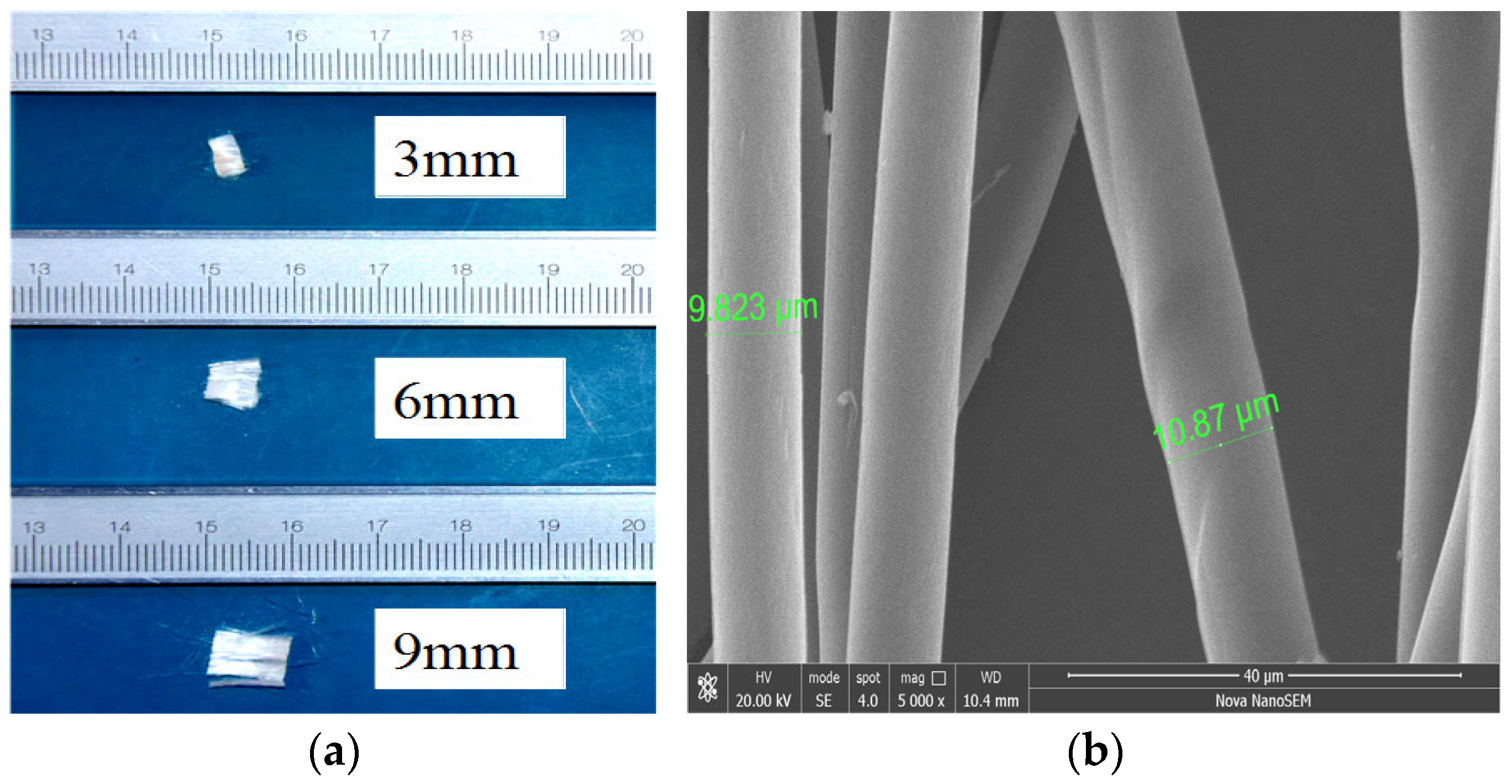


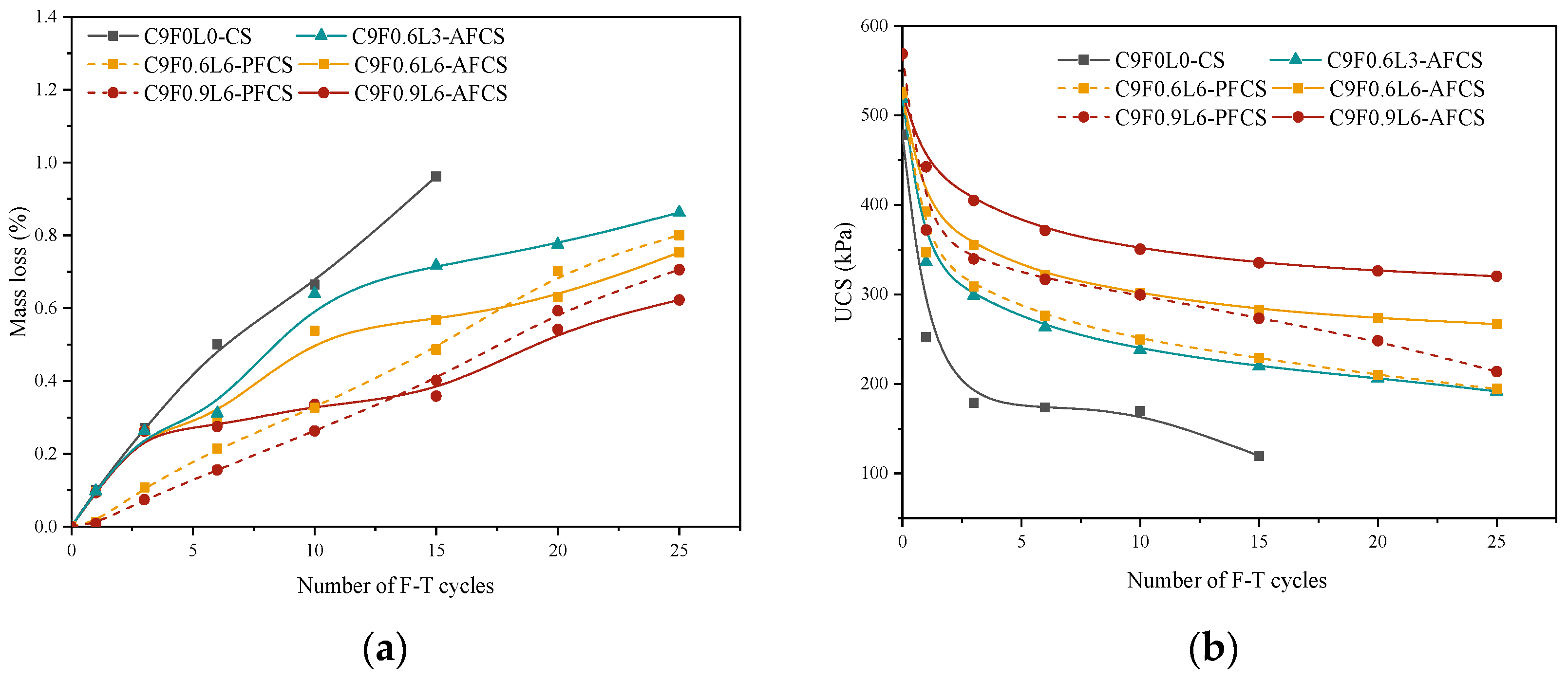

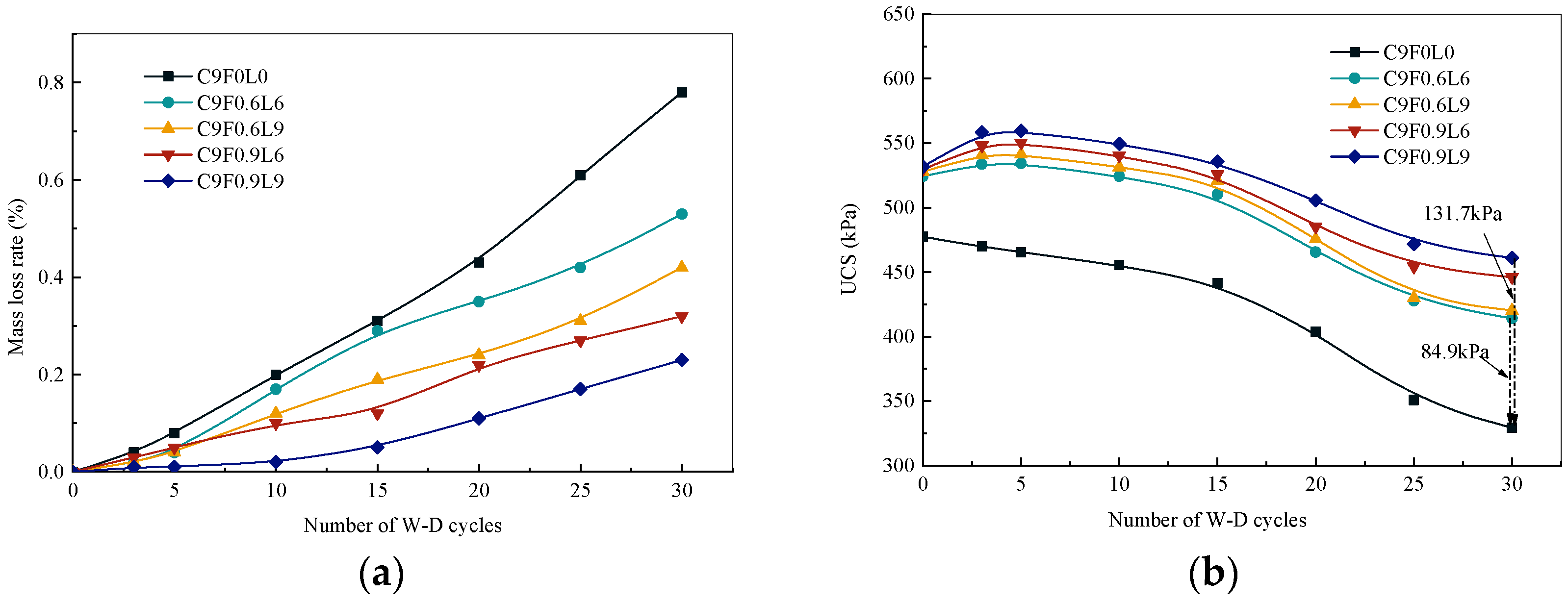


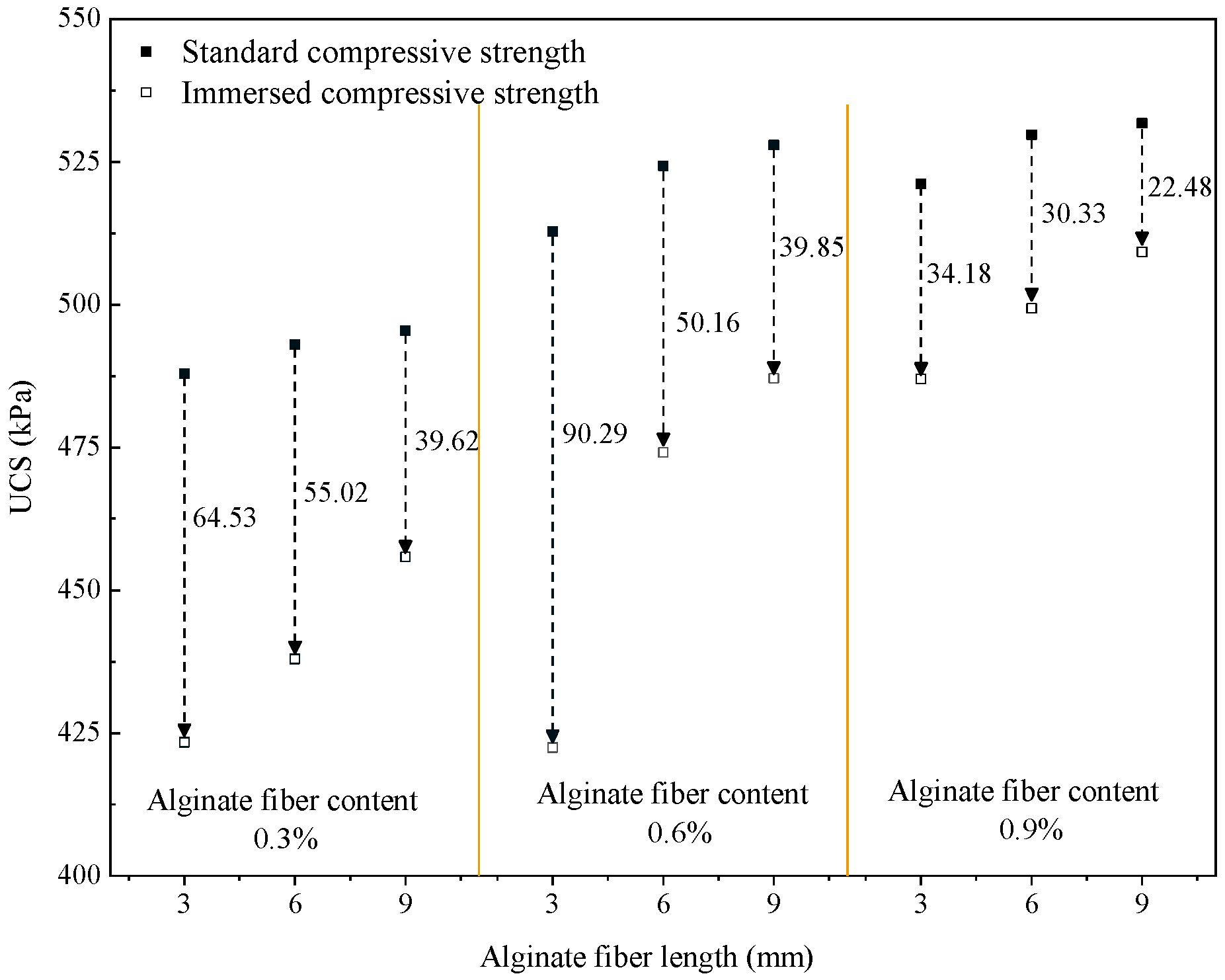

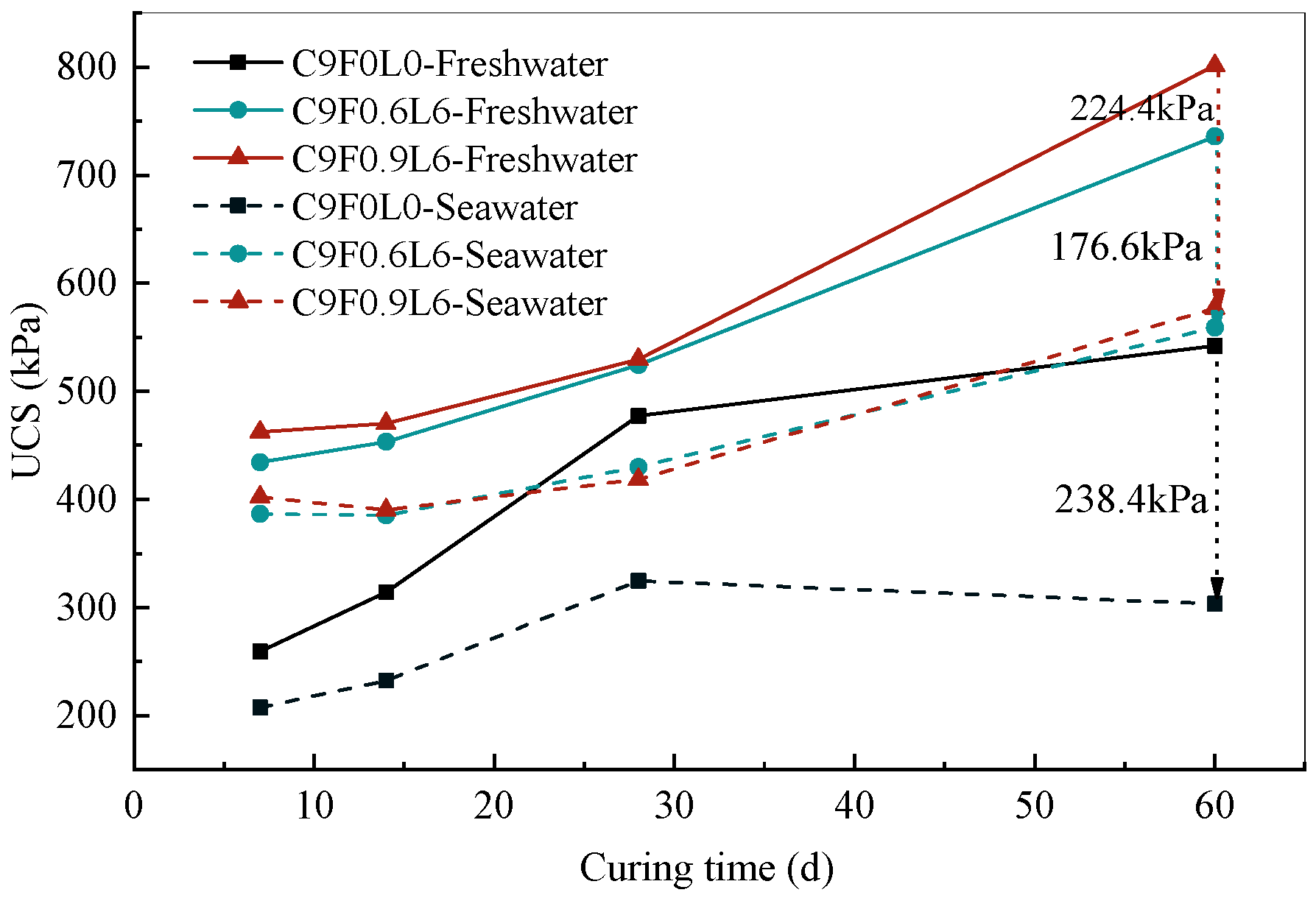

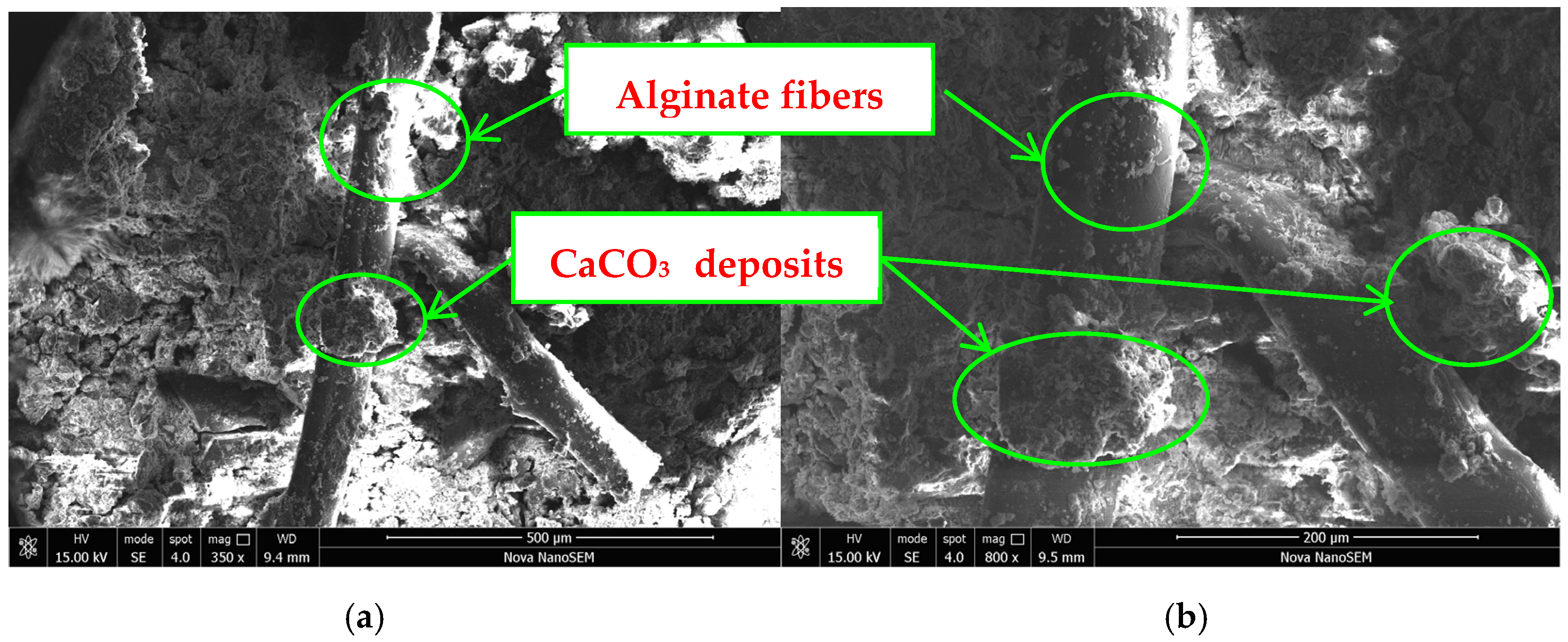
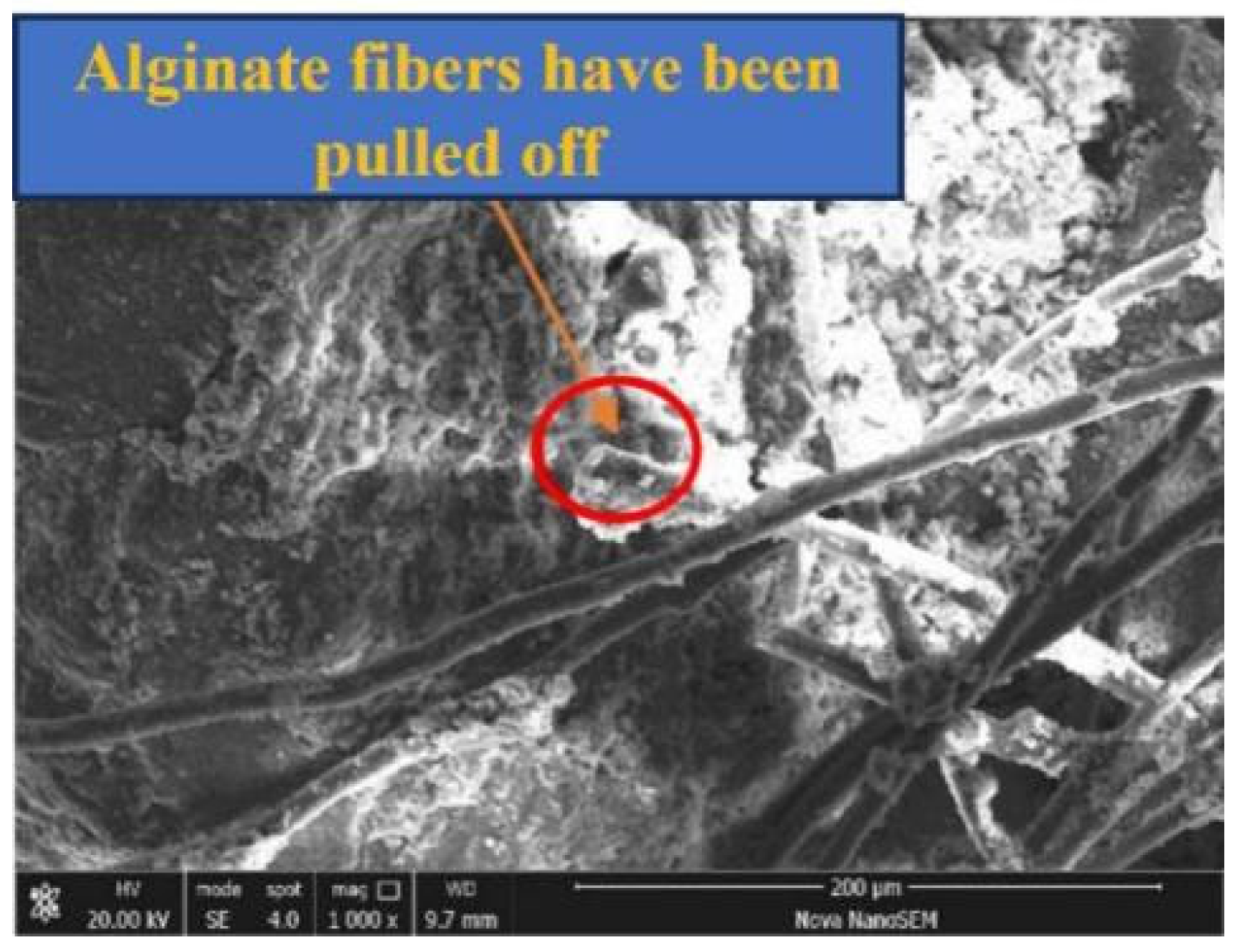



| Water Content /% | Density /(g/cm3) | Liquid Limit/% | Plastic Limit/% | Cohesion /kPa | Internal Friction /° | Specific Gravity | Organic Matter /% |
|---|---|---|---|---|---|---|---|
| 70 | 1.70 | 60.5 | 47.9 | 35.8 | 8.77 | 2.26 | 0.62 |
| Fiber | Color | Tensile Strength /MPa | Elongation /% | Diameter /μm | Density /(g/cm3) |
|---|---|---|---|---|---|
| Alginate fiber | White | 320 | 10.97 | 16 | 0.91 |
| Polypropylene fiber | White | 460 | 10 | 150 | 1.31 |
| Chemical Composition | SiO2 | CaO | Fe2O3 | Al2O3 | Na2O | K2O | MgO | SO3 | Others | Loss on Ignition |
|---|---|---|---|---|---|---|---|---|---|---|
| 21.7 | 57.4 | 2.9 | 7.5 | 0.5 | 0.4 | 1.7 | 3.5 | / | 4.4 | |
| Physical properties | Initial setting time /min | Final setting time /min | Unconfined compressive strength /MPa | Specific surface area /(M2/kg) | Fineness /% | Particle size /% | ||||
| 3d | 28d | <1 μm | 1~3 μm | 3~32 μm | >65 μm | |||||
| 203 | 250 | 27.4 | 45 | 357 | 0.08 | 0 | 81.4 | 18.6 | 0 | |
| Test Sample | Fibers | C/% | T/d | F/% | L/mm | Code Name |
|---|---|---|---|---|---|---|
| F–T cycle test | Alginate fibers; Polypropylene fibers | 9 | 28 | 0, 0.6, 0.9 | 3, 6 |
C9F0L0-CS C9F0.6L3-AFCS C9F0.6L6-AFCS C9F0.9L6-AFCS C9F0.6L6-PFCS C9F0.9L6-PFCS |
| W–D cycle test | Alginate fibers | 9 | 28 | 0.6, 0.9 | 6, 9 |
C9F0L0 C9F0.6L6 C9F0.6L9 C9F0.9L6 C9F0.9L9 |
| Water immersion test | Alginate fibers | 9 | 28 | 0.3, 0.6, 0.9 | 3, 6, 9 | / |
| Seawater erosion test | Alginate fibers | 9 | 7 | 0.6, 0.9 | 6 |
C9F0L0-Freshwater C9F0.6L6-Freshwater C9F0.9L6-Freshwater C9F0L0-Seawater C9F0.6L6-Seawater C9F0.9L6-Seawater |
| SEM test | Alginate fibers | 9 | 28 | 0.3, 0.6, 0.9 | 3, 6, 9 | / |
| Test Name | Items Tested | Test Standard | Test Equipment | Manufacturer |
|---|---|---|---|---|
| F–T cycle test | UCS, mass loss | ASTM D560/D560M-16 [39], ASTM D2166-06 [40] | Naiheng Technology Durability Ace Series Concrete Rapid F–T Test System, Electronic universal testing machine | Beijing Naiheng Technology Co., Ltd. in Beijing, China, MTS Industrial Systems Co., Ltd. in Eden Prairie, MN, USA |
| W–D cycle test | UCS, mass loss, residual strength index | ASTM-D559-15 [41], ASTM D2166-06 [40] | Electronic universal testing machine | MTS Industrial Systems Co., Ltd. in Eden Prairie, MN, USA |
| Water immersion test | UCS, softening coefficient | Wang et al. [42], ASTM D2166-06 [40] | Electronic universal testing machine | MTS Industrial Systems Co., Ltd. in Eden Prairie, MN, USA |
| Seawater erosion test | UCS, degree of seawater erosion damage | Wu et al. [43], ASTM D2166-06 [40] | Electronic universal testing machine | MTS Industrial Systems Co., Ltd. in Eden Prairie, MN, USA |
| SEM imaging | NanoSEM450 Field Emission Scanning Electron Microscope | Oxford Instruments plc, in Oxford, UK |
| Type | C | O | Mg | Al | Si | S | K | Ca | Fe | Cr | Zr | Mo |
|---|---|---|---|---|---|---|---|---|---|---|---|---|
| AFCS | 13.61 | 45.69 | 0.99 | 7.36 | 16.17 | 1.19 | 1.35 | 9.27 | 4.37 | / | / | / |
| PFCS | 24.33 | 25.70 | 0.57 | 4.24 | 8.90 | / | / | 7.13 | 6.28 | 0.30 | 20.02 | 2.54 |
| F | L | a | b | c |
|---|---|---|---|---|
| 0 | 0 | −0.0477 | 0.2091 | 98.804 |
| 0.6 | 6 | −0.0513 | 0.5094 | 100.39 |
| 0.6 | 9 | −0.0587 | 0.7001 | 100.35 |
| 0.9 | 6 | −0.0506 | 0.6111 | 101.20 |
| 0.9 | 9 | −0.0509 | 0.7292 | 101.68 |
| Alginate Fiber Content (%) | Alginate Fiber Length (mm) | Standard Compressive Strength (kPa) | Immersed Compressive Strength (kPa) | Softening Coefficient () |
|---|---|---|---|---|
| 0.3 | 3 | 487.89 | 423.36 | 0.87 |
| 6 | 493.01 | 437.99 | 0.89 | |
| 9 | 495.45 | 455.82 | 0.92 | |
| 0.6 | 3 | 512.78 | 422.49 | 0.82 |
| 6 | 524.28 | 474.12 | 0.90 | |
| 9 | 527.93 | 488.08 | 0.92 | |
| 0.9 | 3 | 521.15 | 486.97 | 0.93 |
| 6 | 529.7 | 499.37 | 0.94 | |
| 9 | 531.74 | 509.26 | 0.96 |
Disclaimer/Publisher’s Note: The statements, opinions and data contained in all publications are solely those of the individual author(s) and contributor(s) and not of MDPI and/or the editor(s). MDPI and/or the editor(s) disclaim responsibility for any injury to people or property resulting from any ideas, methods, instructions or products referred to in the content. |
© 2024 by the authors. Licensee MDPI, Basel, Switzerland. This article is an open access article distributed under the terms and conditions of the Creative Commons Attribution (CC BY) license (https://creativecommons.org/licenses/by/4.0/).
Share and Cite
Wang, Y.; Wang, C.; Hu, Z.; Sun, R. Experimental Study on the Strength Deterioration and Mechanism of Stabilized River Silt Reinforced with Cement and Alginate Fibers. Materials 2024, 17, 3124. https://doi.org/10.3390/ma17133124
Wang Y, Wang C, Hu Z, Sun R. Experimental Study on the Strength Deterioration and Mechanism of Stabilized River Silt Reinforced with Cement and Alginate Fibers. Materials. 2024; 17(13):3124. https://doi.org/10.3390/ma17133124
Chicago/Turabian StyleWang, Ying, Chaojie Wang, Zhenhua Hu, and Rong Sun. 2024. "Experimental Study on the Strength Deterioration and Mechanism of Stabilized River Silt Reinforced with Cement and Alginate Fibers" Materials 17, no. 13: 3124. https://doi.org/10.3390/ma17133124
APA StyleWang, Y., Wang, C., Hu, Z., & Sun, R. (2024). Experimental Study on the Strength Deterioration and Mechanism of Stabilized River Silt Reinforced with Cement and Alginate Fibers. Materials, 17(13), 3124. https://doi.org/10.3390/ma17133124






